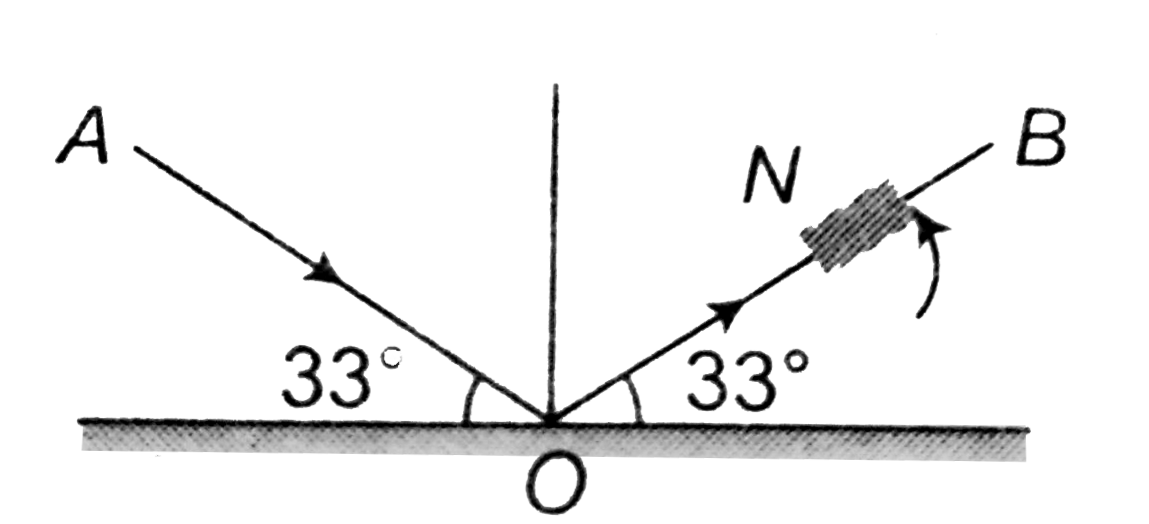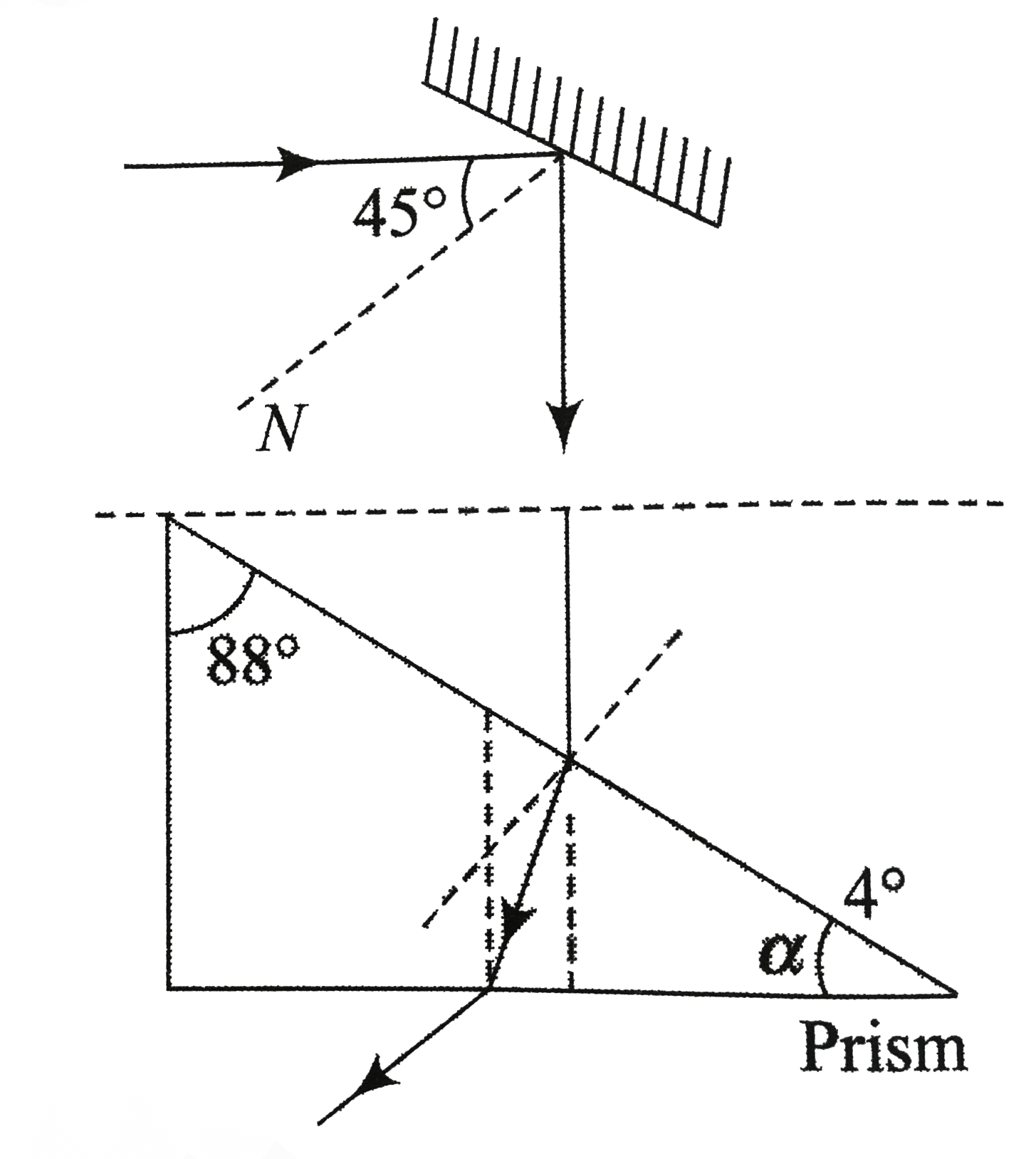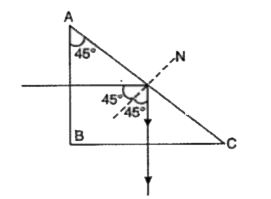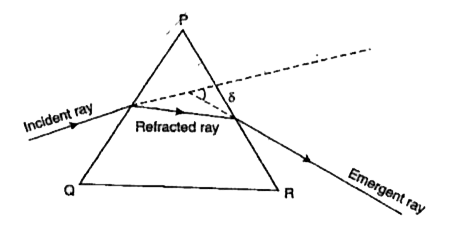A beam of light AO is incident on a glass slab (μ=1.54) in a direction as shown in figure. The reflected ray OB is passed throught a Nicol prism. On viewinf through a Nicole prism, we find rotating the prism that (tan−11.54=57∘)

(a) The intensity is reduced down to zero and remains zero
(b) The intensity reduces down somewhat and rises again
(c) There is no change in intensity
(d) The intensity gradually reduces to zero and then again increases
The correct Answer is:D
In the arrangement shown, the unpolarised light is incident at polarising angle of 90∘−33∘=57∘. The reflected light is thus plane polarised light. When plane polarised light is passed through Nicol prism (a polariser or analyser), the intensity gradually reduces to zero and finally increases.
Topper's Solved these Questions
- BOOK - A2ZCHAPTER - WAVE OPTICSEXERCISE - Problems Based On Different Concepts39videos
WAVE OPTICS
- BOOK - A2ZCHAPTER - WAVE OPTICSEXERCISE - Section B - Assertion Reasoning23videos
WAVE OPTICS
- BOOK - A2ZCHAPTER - WAVE OPTICSEXERCISE - Young'S Double Slit Experiment111videos
WAVE OPTICS
- BOOK - A2ZCHAPTER - SOURCE AND EFFECT OF MAGNETIC FIELDEXERCISE - Section D - Chapter End Test30videos
SOURCE AND EFFECT OF MAGNETIC FIELD
Similar Questions
A beam of light is incident on a glass slab (μ=1.54) in a direction as shown in the figure. The reflected light is analysed by a polaroid prism. On rotating the polaroid, (tan57∘=1.54)
 View Solution
View SolutionA light beam is incident on a rectangular glass plate (μ=1.54) The reflected light OB passes through a nicol prism.
On observing the transmitted light while rotating the prism, it is seen that
 View Solution
View Solution
Knowledge Check
- Question 1 - Select One
A beam of light AO is incident a glass slab (μ=1.54) in the direction show. The reflected ray OB is passed through a Nicol prism. On viewing through a Nicol prism, we find on rotating the prism that
 Athe intensity is reduceed down to zero and remains zeroBthe intensity reducees down somewhat and rises againCthere is no change in intensityDthe intensity gradually reduces to zero and then again increases
Athe intensity is reduceed down to zero and remains zeroBthe intensity reducees down somewhat and rises againCthere is no change in intensityDthe intensity gradually reduces to zero and then again increases - Question 2 - Select One
If unpolarized light falls on a glass plate (μ=1.54) at an incidence angle of 57∘, the reflected light is
AunpolarizedBcompletely polarized with dot vibrationsCcompletely polarized with dash vibrationsDpartially polarized with 15% dot and 85% dash vibrations - Question 3 - Select One
If unpolarized light falls on a glass plate (μ=1.54) at an incidence angle of 57∘, the reflected light is
AunpolarizedBcompletely polarized with dot vibrationsCcompletely polarized with dash vibrationsDpartially polarized with 15% dot and 85% dash vibrations
A ray of light strikes a plane mirror at an angle of incidence 45∘ as shown in Figure . After reflection,l the ray passes through a prism of refractive indes 1.5 whos apex angle is 4∘. Through what angle must the mirror be rotated it total deviation of the ray be 90∘ ?
 View Solution
View SolutionA ray of light passes through a right angled prism as shown in the figure. State the angle of incidence at the faces AC and BC.
 View Solution
View SolutionA ray of light is incident on a glass plate of refractive index 1.54. If the reflected ray is completely plane polarised, find (i) angle of incidence (ii) angle of refraction and (iii) crictical angle. Given tan57∘=1.54 and sin40.5∘=0.6493.
View SolutionA ray of light passes through a prism as shown in the figure.

The angle δ is known asView SolutionIf the light waves pass through a nicol prism then all the oscillations occur only in one plane, such beam of light is called as
View Solution

